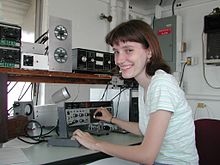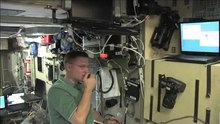Radio amateur


A radio amateur (short: "Ham" from English ham radio operator for amateur radio operator ) is a person who deals with the field of amateur radio . In most countries, an examination certificate is required to transmit on the frequencies approved for this purpose. B. an amateur radio certificate or license. Ownership of the devices required for this can be restricted by law depending on the country.
Concept formation
For Germany, the Amateur Radio Act of 1997 defines :
- "Radio amateur is the holder of an amateur radio certificate or a harmonized amateur radio examination certificate on the basis of the order 9/1995 of the Federal Ministry of Post and Telecommunications of January 11, 1995 (Official Gazette p. 21), which deals with the amateur radio service out of personal inclination and not for commercial reasons -economic interest. "
According to the law, you are already a "radio amateur" in Germany, even if you do not (yet) have a call sign, but (after passing the amateur radio test) you have an amateur radio certificate. However, you can only actively participate in amateur radio, ie “go on the air”, if you have also received (on separate request) the “ authorization to participate in the amateur radio service ” and thus also the personal amateur radio call sign.
For Austria the law defines that the radio amateur is the holder of an amateur radio license, so the amateur radio certificate is not sufficient.
If someone only receives transmissions, they are called receiving amateurs or simply short wave listeners (SWL - Short Wave Listener).
details
The hobby of a radio amateur is to set up and operate an amateur radio station. The operation of radio transmission systems is subject to approval. Every radio amateur must prove his / her expertise (in the fields of technology, operating technology and regulations) in a written test. This test is usually carried out by the competent authority, rarely also directly by amateur radio associations (e.g. in the USA). After passing the exam, the would-be radio amateur receives his amateur radio certificate. With the amateur radio certificate, admission to the amateur radio service can be applied for. By being authorized to participate in the amateur radio service , with which the radio amateur is simultaneously assigned his worldwide unambiguous amateur radio call sign, the radio amateur acquires in particular the right, deviating from the conformity assessment procedure usually stipulated, to manufacture the radio equipment of his amateur radio station himself, as well as commercially available transmitter systems that use amateur radio bands have been rebuilt to operate. With this call sign he may use the amateur bands assigned to amateur radio . To do this, he puts together his own amateur radio station with one or more (possibly self-made) radios. Due to the expertise demonstrated during the test, radio amateurs are the only ones who have the right to build their own transmitters. As a broadcast operator, radio amateurs also have the same obligations as all commercial frequency users. For example, contributions have to be paid annually for frequency allocation or for the work of the authority in the field of electromagnetic compatibility , and radio amateurs are also required to provide evidence of the harmlessness of electromagnetic emissions. In some countries there are simplified procedures for radio amateurs for this verification. As certified experts, radio amateurs can often document their system themselves.
With their radio station radio amateurs maintain contacts with other radio amateurs all over the world. The radio amateur may only conduct radio communications with other amateur radio stations. He may not transmit messages that do not concern the amateur radio service for or to third parties (exception: emergencies).
Radio amateurs are often the only connection to the outside world with failed communication networks, as they can set up intercontinental radio links with the simplest means. This radio traffic is called emergency radio .
The abbreviations used by radio amateurs include, for example, the two double letters YL ("Young Lady") for a radio amateur and OM ("Old Man") for a male radio amateur, in both cases regardless of age.
Prominent radio amateurs
The physicists James Clerk Maxwell (1831–1879) and Heinrich Hertz (1857–1894) were two important pioneers in radio technology . In their time, the term "radio amateur" did not yet exist. They were followed by radio pioneers like Alexander Stepanowitsch Popow (1859–1906), Roberto Landell de Moura (1861–1928) and Guglielmo Marconi (1874–1937). You are among the first to deal with “sparks” out of personal inclinations and interests, ie with the generation, propagation and reception of electromagnetic waves .
The following people are among the celebrities who are or were radio amateurs, mostly for other reasons or in other fields :
- Heads of State, politicians
- Bhumibol Adulyadej (1927-2016), King of Thailand, HS1A
- Francesco Cossiga (1928-2010), Italian politician, callsign I0FCG
- Hussein I (Jordan) (1935–1999), King of Jordan, JY1
- Juan Carlos I (* 1938), (abdicated) King of Spain, EAØJC
- Rajiv Gandhi (1944–1991), Indian politician, VU2RG
- Barry Goldwater (1909-1998), US Senator, K7UGA
- Juscelino Kubitschek de Oliveira (1902–1976), President of Brazil, PY1JKO
- Carlos Menem (* 1930), President of Argentina, LU1SM
- Friedrich Merz (* 1955), German politician, DK7DQ
- Keizo Obuchi (1937–2000), Japanese Prime Minister, JI1KIT
- Mohammad Reza Pahlavi (1919–1980), Shah of Persia, EP1MP
- George Pataki (* 1945), Governor of New York, K2ZCZ
- U Thant (1909–1974), UN Secretary General, XZ2TH
- Science, technology and business
- Nolan Bushnell (* 1943), founder of the Atari computer company , W7DUK
- Ward Cunningham (* 1949), programmer of the first wiki software, K9OX
- Léon Deloy (1894–1969), discoverer of the short wave, (F) 8AB
- Guillermo González Camarena (1917–1965), inventor of color television, XE1GC
- Abraham Esau (1884–1955), first VHF transmission 1925, EK4AAL
- Reginald Fessenden (1866–1932), first wireless voice transmission, 1XS
- Michael Griffin (* 1949), Director of NASA, NR3A
- Wau Holland (1951–2001), German journalist and computer activist, DB4FA
- Ibuka Masaru (1908-1997), co-founder of Sony, J3BB
- Jack Kilby (1923-2005), inventor of the microchip, W9GTY
- Joseph Kittinger (* 1928), combat, parachute and balloon pilot, N4HDP
- Kevin Mitnick (* 1963), American hacker, N6NHG
- Morita Akio (1921-1999), co-founder of Sony, JP1DPJ
- David Packard (1912-1996), co-founder of Hewlett-Packard , 9DRV
- Grote Reber (1911–2002), founder of radio astronomy, W9GFZ
- Ulrich L. Rohde (* 1940), German-American high-frequency engineer, entrepreneur and university lecturer, N1UL, DJ2LR
- Harold A. Rosen (1926–2017), developer of the first geostationary satellite, W5JKW
- Samuel Ruben (1900–1988), developer of the mercury button cell and co-founder of Duracell , 2ASP
- John Sculley (* 1939), Manager of Pepsi and Apple, K2HEP
- George E. Smith (* 1930), physicist and Nobel Prize winner, AA2EJ
- Percy Spencer (1894–1970), inventor of the microwave oven, W1GBE
- George Sweigert (1920–1999), inventor of the cell phone, N9LC
- Joseph Hooton Taylor Jr. (* 1941), astrophysicist and Nobel Prize winner, K1JT
- Robert K. von Weizsäcker (* 1954), economist, DL1BOB
- Steve Wozniak (born 1950), Apple co-founder, WA6BND
-
Spacemen (most spacemen are or were radio amateurs)
- Alexander Gerst (* 1976), German geophysicist and astronaut, KF5ONO
- Other known people
- Chet Atkins (1924-2001), American country musician, W4CGP
- Tex Beneke (1914–2000), American jazz saxophonist, singer and big band leader, K0HWY
- Walter Cronkite (1916–2009), American television journalist and news anchor, KB2GSD
- Marlon Brando (1924-2004), American actor, FO5GJ
- Maximilian Kolbe (1894–1941), Polish monk and martyr, SP3RN
- Paul-Émile Léger (1904–1991), Archbishop of Montreal, TJ1BC
- Curtis E. LeMay (1906–1990), organizer of the Berlin Airlift and commander of the Strategic Air Command , K0GRL
- Roger Mahony (born 1936), Archbishop of Los Angeles, W6QYI
- Priscilla Presley (* 1945), American actress, N6YOS
- Cliff Richard (born 1940), British pop singer, W2JOF
- Joe Walsh (* 1947), American rock musician, guitarist for the "Eagles", WB6ACU
- Tim Allen (born 1953), American actor, KK6OTD
- Abdullah Al Qassimi, rally driver, A61AQ
- Stuart Alden "Stu" Cook (* 1945), American musician, bassist for Creedence Clearwater Revival , N6FUP
- Kimberly Claffy "kc Claffy" in 2017 with the Jonathan B. Postel Service Award awarded
See also
- Amateur radio operator
- List of amateur radios
- List of abbreviations in amateur radio
- Contest (amateur radio)
Individual evidence
- ↑ DK5KE Morse Code Page - Amateur Radio Abbreviations. Retrieved May 28, 2011 .
- ^ Abbreviations in amateur radio in the amateur radio wiki of the German Amateur Radio Club and the Adacom professional association for amateur data radio e. V.
- ↑ Hans Schwarz: Yearbook for the radio amateur 2009 . In: DARC book series amateur radio advice . tape 24 . DARC Verlag GmbH, Baunatal 2008, ISBN 3-88692-057-7 , 3.2 Other abbreviations, p. 21-36 .
- ↑ Famous Hams and ex-Hams. www.qsl.net, accessed on May 28, 2011 (English).
- ^ License Search. wireless2.fcc.gov, accessed May 28, 2011 .
- ↑ HS1A Silent Key. In: dxnews.com. October 14, 2016, accessed November 2, 2016 .



